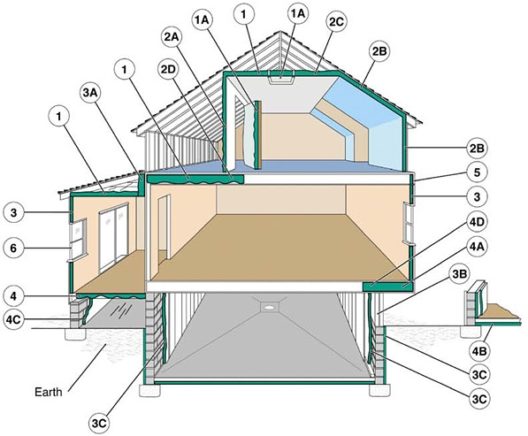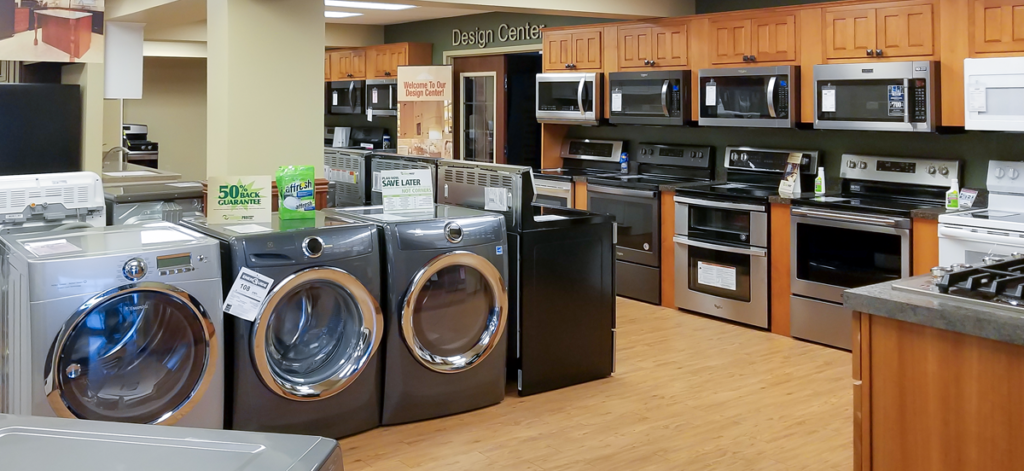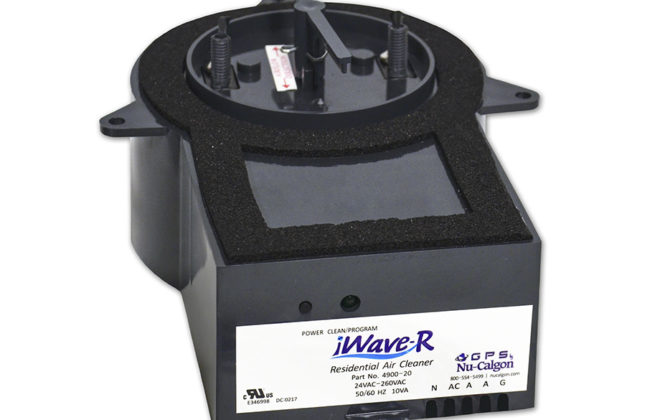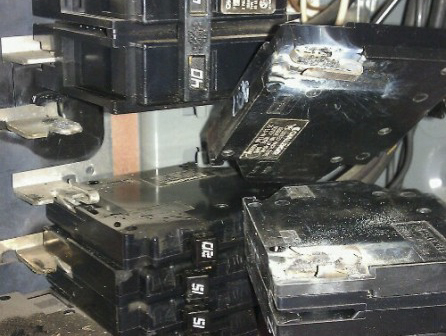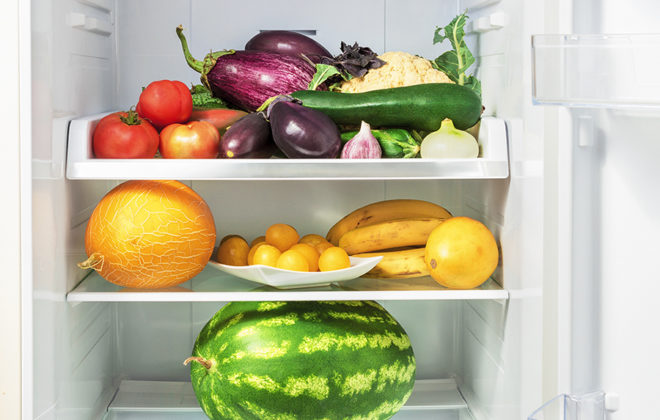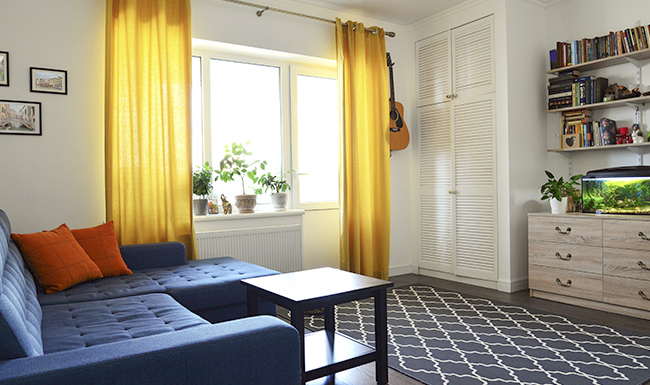
Easy Ways to Make Your Home Eco-Friendly
Are you looking for easy ways to make your home more eco-friendly and energy-efficient? There are lots of simple, practical steps that you can take to decrease your home’s carbon footprint. Learn how to save money and energy at home without sacrificing comfort.
Kitchen
Refrigerator Seal
One of the biggest consumers of energy in your home is the refrigerator. It keeps many of the essential ingredients for cooking and allows you to enjoy leftovers for several days/weeks after the big meal. Keep the energy inside where it belongs. Make sure that the refrigerator and freezer doors close tightly. A broken or loose seal will not only waste energy, but won’t adequately keep perishables fresh. Check both doors to ensure they close tightly, and have them fixed if they show signs of wear.
Alternative Cooking Methods
Use a pressure cooker or microwave for certain dishes to use less electricity. While pressure cookers and microwaves aren’t always an option, you’d be surprised how versatile they can be. A toaster oven is also a good alternative for reheating leftovers that require some crispiness.
Also, consider cooking meals in your fireplace or outdoor fire pit. If you’re making a fire anyway, save energy by cooking a meal with it.
Use a Kitchen Exhaust
You can lessen the amount of indoor heat when cooking or using your microwave by installing and using a kitchen exhaust. An exhaust fan is also great for removing odors, moisture, and heat from the bathroom.
Family Room and Bedroom
Use Ceiling Fans
Saving energy is a breeze with fans. Consider installing ceiling fans and whole-house fans to reduce the demand on your air conditioning system. Since fans only costs a few cents to run per hour, you can save a lot of money on air conditioning costs.
While ceiling fans don’t actually lower or increase the temperature of a room, they can increase your comfort and save you a lot of money. Don’t forget to turn off fans when you leave the room as they won’t do anything if nobody’s around. Get in the habit of using your cooling and heating system in conjunction with ceiling fans.
In order to reverse the blades on a ceiling fan, simply flip the switch (usually attached to the motor casing) from down to up. When the blades are reversed, it also reverses the air flow (from down to up). Make sure to run the fan on the lowest setting. In the winter, you simply want to recirculate the air, not create a breeze.
Make Electronics More Efficient
Use power strips to avoid standby energy loss. Multiple devices and electronics can be plugged into them, making it easier to control their consumption.
The Attic
Add Insulation
Although attic insulation is critically important for home energy efficiency, it is not exactly a small project. You can DIY it however. Here is a link to how to insulate your attic on a budget, how to use blown-in cellulose insulation on your attic, followed by a list of biggest mistakes in adding attic insulation.
According to The Family Handyman, “homes should have attic insulation between R-22 and R-49 (6 to 13 in. of loose fill or 7 to 19 in. of fiberglass batts).”
Use this U.S. Department of Energy Insulation Guide to learn how much insulation you need in your attic (R-value).
Another tip for sealing air leaks is to replace old doors and windows, which can be a major source of air leaks. Newer models of doors and windows can help to cut down on your energy loss, leading to a more economical and comfortable home.
When insulating your home, you want to carefully inspect your entire home, from top to bottom. Here is a great diagram we found on energy.gov, which highlights some of the typical areas in your home that can benefit from caulking and weatherstripping:
1. In unfinished attic spaces, insulate between and over the floor joists to seal off living spaces below. (1A) attic access door
2. In finished attic rooms with or without dormer, insulate (2A) between the studs of "knee" walls, (2B) between the studs and rafters of exterior walls and roof, (2C) and ceilings with cold spaces above. (2D) Extend insulation into joist space to reduce air flows.
3. All exterior walls, including (3A) walls between living spaces and unheated garages, shed roofs, or storage areas; (3B) foundation walls above ground level; (3C) foundation walls in heated basements, full wall either interior or exterior.
4. Floors above cold spaces, such as vented crawl spaces and unheated garages. Also insulate (4A) any portion of the floor in a room that is cantilevered beyond the exterior wall below; (4B) slab floors built directly on the ground; (4C) as an alternative to floor insulation, foundation walls of unvented crawl spaces. (4D) Extend insulation into joist space to reduce air flows.
5. Band joists.
6. Replacement or storm windows and caulk and seal around all windows and doors.
Source: Oak Ridge National Laboratory
The Water Heater
Use Cold Water More Often
We begin with the easiest most obvious tip, but one that can be very effective if given some thought. Using cold water for most laundry loads, house cleaning and everyday grooming will go a long way in reducing your utility bill.
Turn Down the Thermostat
This is a very effective way to reduce the amount of energy used. Most tank manufacturers set their water heaters at 140°F, but 120°F should be warm enough for most people. After you’ve adjusted the thermostat, check to see how the hot water feels from your faucet. It’s unlikely that you will notice a substantial difference in temperature. This tip not only helps you save money on utilities, but it also helps slow mineral buildup and corrosion.
Drain the Tank
This is something that you should do every 3 months to ensure maximum efficiency. Draining the tank helps remove sediment buildup, which impedes heat transfer and can compromise the system. It’s a relatively easy procedure, but a bit time-consuming so give yourself a sizeable window.
Consider Going Tankless
Many consumers are switching to tankless water heaters because they can cost less to operate than a traditional water heater, minimizing costs and offsetting initial installation costs. A tankless water heater system can save $44 to $108 a year on hot water costs for a typical Roanoke home.
Tankless water heaters are available in both electric and gas versions. They can cost a bit more upfront, but the team at Southern Trust can work with you to assess your needs and help you decide which type of water heater or tankless water heater is right for you. Regardless of whether you want to install a new tankless water heater or need an inspection or repair of the existing hot water heater in your Pennsylvania home, contact Brubaker Inc. to have a trusted technician explain all your options.
All Rooms
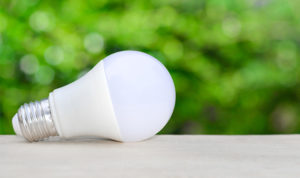 Switch Out Your Light Bulbs
Switch Out Your Light Bulbs
A lot of homeowners are still using inefficient incandescent light bulbs. Change out your old incandescent light bulbs with more efficient designs. Light bulb technology has changed drastically within the past decade.
While more energy-efficient bulbs have been on the market for years, it’s only recently that they have become cheaper and easier to find. While compact florescent bulbs (CFLs) and light emitting diodes (LEDs) are still a bit more expensive than the incandescent variety, they make up for it in energy consumption and longevity. A 60 watt incandescent bulb will last about 1,200 hours and consume 3285 KW/yr. Compare those numbers to comparable CFL and LED bulbs; CFLs will last 8,000 hours and use 767 KW/hr. while LEDs will last 50,000 hours and use 329 KW/yr. Obviously, by simply changing out the bulb designs you will be drastically cutting your kilowatt consumption.
Turn Off Lights and Devices That Aren’t In Use
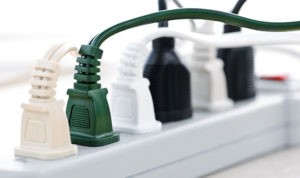 Every household has those appliances that are left plugged in at all times just because someone might need to use on a rainy day. It’s more convenient to leave the appliance plugged in at all the times, than it is to plug it in only when it’s in use. Whether it’s a stand mixer that you use once in a blue moon, or a blender that’s used once a week, there’s no need for it to be drawing energy 24/7, so make it a habit of unplugging them after each use.
Every household has those appliances that are left plugged in at all times just because someone might need to use on a rainy day. It’s more convenient to leave the appliance plugged in at all the times, than it is to plug it in only when it’s in use. Whether it’s a stand mixer that you use once in a blue moon, or a blender that’s used once a week, there’s no need for it to be drawing energy 24/7, so make it a habit of unplugging them after each use.
Computers, phones and tablets are among the most used electronic devices. We often charge these devices overnight, however, we all know none of these devices take 8 hours to charge. Instead of keeping your device on the charger all night, plug it in a few hours before you go to bed.
This one’s pretty basic, but can make all the difference. Whenever you leave a room, turn the lights off! Sometimes we get pretty lazy and the light switch isn’t exactly “closest” to you, or we adopt the “I’ll do it later,” but this kind of habit only costs you money. Lights account for 5 to 10 percent of your energy bill, so by turning off lights that aren’t you will save money on your energy bill.
Put computers, entertainment systems, and video games on a UL-certified power strip. Turn the power strip off when devices are not in use to eliminate standby power loss, also known as “vampire energy”. Common energy vampires include:
• Computers
• Computer Monitors
• Printers, Scanners, and Fax Machines
• Televisions
• Audio Equipment
• Phone/Gadget Chargers
• Video Game Consoles
• Electric Clocks
• Kitchen Appliances (including coffee makers and microwave ovens)
• Large Appliances (washer/dryers, ovens)
Replace Windows
As fuel prices rise and temperatures get more extreme, now might be the time to start thinking about replacing your old, inefficient windows with insulating, double-pane substitutes. Those looking for improved soundproofing, safety, security, and efficiency will be interested in today’s energy-efficient window market.
When it comes to upgrading your windows, single-pane windows might be inexpensive, but they are also ineffective at reducing heat flow into and out of the building. If you are adding or replacing windows, double- and triple-pane windows are the preferred choice.
The main difference between single- and double-pane windows is that double-pane windows have a small space in between the two panes for added strength and insulation. Single-pane windows don’t have any space since only one pane of glass is used.
Triple-pane windows are very similar to double-pane windows, except the triple- pane windows have two air spaces instead of one. Although heavier and more expensive, triple-pane windows offer greater energy efficiency, about one-third more than double-pane windows.
U-factor is a rating system created by the National Fenestration Rating Council (NFRC). This basically measures the ability of the window to keep heat from escaping. U is the inverse of resistance (R), so the lower the U-factor, the more efficient the windows
A low-E, double-pane window has a U-factor of about .26. Other NFRC window performance factors are solar heat gain coefficient, air leakage, condensation resistance, and visible transmittance.
Multiple glazing and low-E coatings are definitely worth the money, with payback taking just a couple of years.
If you experience a lot of street noise, thicker windows with air spaces are great for dampening the sound.
Install Window Screens
To keep the cool air inside and prevent solar heat from getting in, you should consider installing window screens. They are also referred to as solar screens or mesh screens and are popular for their ability to intercept up to 70 percent of solar energy. They are absolutely beneficial especially for those windows facing the east and the west. Another great thing about these is that they can also keep the insects out of your home even if your windows are open.
Aside from screens, window films are also a great alternative. They are metallic, transparent sheets that reflect solar energy or heat before it is transmitted through glass windows. Take note, however, that windows should be shut close to be able to use films.
Turn the Thermostat Down
Your thermostat setting contributes on your electricity consumption. By letting it stay at 78 degrees or warmer, you’ll save 5 to 15 percent on your electricity bill. If you’d like to keep your home cool when you’re there, at least turn the thermostat higher when you leave or at night, when the temperature outside is cooler.
New Appliances
How long have owned your major appliances? If you have owned some over a decade, you might consider replacing them with Energy Star products. Clothes dryers, which consume a large amount of energy, would be first on the list for assessment. Energy Star certified dryers use about 20 percent less than conventional units. Through new, innovative designs, their features and performance levels are also comparable to similar models in the marketplace. Other products certified by Energy Star include clothes washers, refrigerators, dishwashers, televisions and more. These systems have to meet the stringent requirement set forth by the Environmental Protection Agency. All are designed to operate better and consume less energy than comparable models.
Outdoors
Use Xeriscaping Techniques
By using native and drought-resistant plants for your landscaping, you can save on water use and help improve drainage. Not only that, hardscaping and xeriscaping also reduces the need for mowing and maintenance.
Collect Rainwater
Ask your plumber about rainwater collection systems so you can use rainwater to help naturally irrigate you yard.
Air Dry Laundry
If you are looking for a way to maintain the shape and size of your clothing while also saving energy and money, consider air drying your clothes. You can use a good old-fashioned clothesline strung between some trees in your yard or a drying rack for lighter items. Hang your clothes whenever possible. For the heavier items that need the dryer, you’ll be able to reduce the time needed by taking out clothes to air dry.
HVAC System
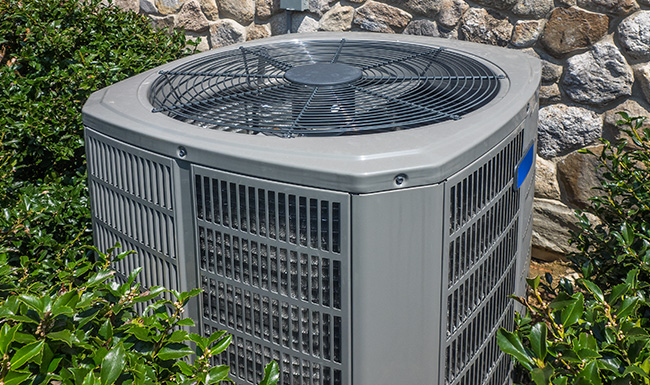 Outdoor Unit
Outdoor Unit
• Remove Debris from Outdoor Coil – If your yard contains several trees or bushes, there’s a good chance that foliage, branches, and other debris have blown into or against the coil. AC coils are designed to transfer heat and any obstructions can greatly affect the performance. You’ll want to remove any obstructions and make sure to clean away any debris in the area. Consider covering your outdoor unit with a simple plywood cover for winter.
• Inspect Outdoor Unit Panels – The unit panels enclose and secure the electrical connections. They must be in place to protect the system. If a panel is misaligned or missing, this could also affect the performance and ultimately damage the equipment. If a panel has been damaged or lost, call a professional to assess the situation before you start the unit.
• Check for Damaged Pipe Insulation – The suction line (the larger copper pipe) supplies refrigerant back to the compressor in the outdoor unit. If the suction pipe has damaged insulation, this could cause a loss of required cooling which could damage the unit – and waste energy. Causes for the damage include sun rot, freezing water, or animals seeking shelter. The insulation should be intact to maintain system cooling. If the insulation needs replacing, do so before starting the unit.
• Check Condenser Covers/Coil Blankets – You may have covered the outdoor coil for protection throughout the winter. If so, checking to ensure that it is secure is important (especially in Oklahoma where the wind itself can cause severe damage). You will also want to make sure that any covers or blankets are removed from the system before you turn it on. Many people forget to remove protective coverings which can result in costly repairs.
Indoor Unit
• Check the Supply Vents and Return Grills – Inspect both the supply and return air grills and vents to make sure that they are open and clean from dust and debris. If you own a pet you might consider using a vacuum to remove the fine hairs that can wreak havoc on these smaller units. Clean vents and grills will ensure maximum efficiency and keep utility bills down.
• Change the Air Filters – After several months of non-use, the filter has likely accumulated some dust and debris. To ensure that your indoor unit is running efficiently, check your air filter every month, and don’t wait more than 3 months to replace it. This is probably one of the most important (and simple) maintenance procedures that you can do on your own.
• Check the Coil Drainage Hose – Also referred to as the “condensate line,” this (usually plastic) component drains the condensation gathered on a tray from the coil. If the hose is damaged or dislodged, the tray will fill up and flood the unit and could cause potential flooding. Check to make sure that the line is attached and in running condition. (Under no circumstances should water be leaking from an indoor air conditioner!)
• Trial Run – The best way to make sure that your indoor unit is running properly is to simply turn it on. During the first warm spring day, make sure that you can feel cold air coming through the registers. If the air isn’t cool, or hasn’t cooled within a couple of minutes, something is wrong. Turn off the system and check the vents and hose once again. Never leave a system running if it is not working properly. Any problem will exacerbate and cause more damage. Call a professional HVAC technician and have the unit assessed.
Professional HVAC Maintenance
Just like a car will decline in performance without regular maintenance, so will your air conditioning unit. Remember to schedule professional HVAC maintenance twice a year—once in the fall for heating and once in the spring for cooling. When you schedule an annual HVAC maintenance appointment with a professional, they will:
1. Check refrigerant
2. Test for leaks
3. Check duct system for leaks and airflow
4. Measure airflow through the evaporator coil
5. Check electrical system
6. Inspect electric terminals
7. Clean and tighten connection
8. Oil motors and check belts
9. Check thermostat accuracy
Seal Leaky Ducts
According to Energy Star, 20 to 30 percent of the air moving through a typical duct system is lost due to leaks or poorly connected ducts. These leaks can clog air filters, compromise your indoor air quality and cause considerable damage to your HVAC. They can also result in higher utility bills. If you have leaks and the problem is confined to exposed ducts, there are several DIY solutions you can explore. You can find an array of sealant products including foam, latex and mastic tape available at your local home improvement store if you want to take on a project. However, if your system is older and has considerable damage, it’s best to call an HVAC company to have them sealed professionally. Learn more about the benefits of duct sealing.
Should you replace your HVAC system?
Heating and cooling are the biggest drains on your electricity bill, which is why it makes sense to thoroughly examine any problems you may be having. Here's a list of questions you should ask yourself when deciding whether it is time to replace the HVAC system:
• Is your system more than 10 years old?
Units that are a decade or older should probably be replaced with a high-efficiency design that has earned an Energy Star label. These newer designs can save up to 20% on your electric bill.
• Does your equipment need frequent repairs? If your HVAC has been repaired more than once in a calendar year (not including regular maintenance), it might make sense to look into replacing it.
• Are your energy bills are going up? Your unit may have become less efficient.
• Are some rooms in your home too hot or too cold? Duct problems or inadequate insulation might be the cause.
• Does your home have humidity problems? The cause might be poor equipment operation, inadequate equipment, or leaky ductwork.
• Does your home have excessive dust? A leaky duct can pull dust and debris from attics and basements. Sealing ducts could be a solution.
• Is your heating or cooling system noisy? You might have an undersized duct system, which would put a major strain on your HVAC.
If the answer to any of these questions is “yes,” you might be in the market for a new HVAC (heating, ventilation and air conditioning system). But before you commit to an expensive new unit, it would be a good idea to have an energy assessment completed by a professional technician.
Home Energy Audit
Depending on the nature of the problem, this could either be a simple walk-through assessment, or a more comprehensive audit. Your auditor may suggest a blower-door test that essentially pressurizes the house to detect any energy leaks. If an assessment reveals that there are any leaks in your home, insulation might be the key to your problems.
Sealing any leaks and properly insulating problem areas will help your HVAC system run more efficiently. (Many states offer incentives including subsidies, rebates, and discounts for completing an energy assessment or other energy-saving work.) You might discover that you don’t need to replace your unit, but if you do, you will have the guidance of a professional to help choose the ideal design for your needs.
If you do decide to replace your HVAC system, make sure you give us a call for all your installation and maintenance needs.
Some quick and easy ways to save energy at home:
• Switch out incandescent light bulbs with energy-saving LEDs.
• Install timed light fixtures for areas like closets, laundry rooms, and garages.
• Use shades, curtains, and other window treatments to block the hot solar rays.
• Clean dryer’s exhaust tube.
• Wrap water heater in insulating blanket
• Use natural pest prevention methods.
• Use a programmable or smart thermostat to save about 5-10% on your heating and cooling bill.
Why Brubaker Inc.?
At Brubaker Inc., we’re focused on expert electrical and customer service. All of our licensed electricians are highly trained, background checked, and drug tested for your safety and comfort. We offer the following guarantees:
• 100% Satisfaction Guarantee
• Fully Licensed and Insured in Georgia
• Live Call Center (No Machines)
• Courtesy Call Before Arrival
• Courtesy Call After Service
• Family Owned and Operated
• After-Hours Emergency Service
• Financing Available
• Safe, Contactless Service
If you aren’t completely satisfied with the service you receive from Brubaker Inc., simply give us a call and we’ll fix the issue to your satisfaction, or you’ll get your money back. That’s a guarantee!
Related Posts
Categories
Recent Posts
- Brubaker Inc: One Year as an Employee-Owned Company & Why It Matters to You
- Top 5 Signs It’s Time to Replace Your Heating System in Lancaster, PA
- Aimee Deraco: Small Businessperson of the Year at the 2024, Lancaster Chamber Dinner
- Home Heating Hacks to Save Money and Energy
- Combat Winter Dryness and Sickness
- How to Keep Your White Clothes Looking Fresh
- 4 Smart Upgrades for Your Plumbing
- Top Kitchen Remodeling Trends and Options for 2021
- Who invented the dishwasher?
- Frozen Pipes?

